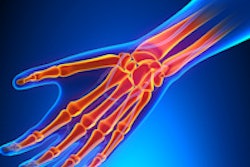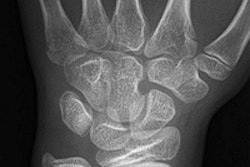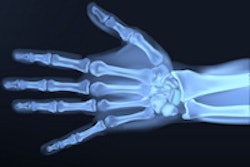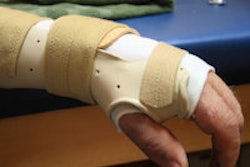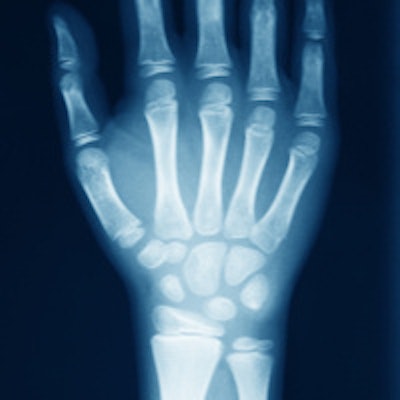
Researchers from Turkey found that radiography missed one-third of wrist fractures compared with multidetector-row CT (MDCT), according to an article published online on October 18 in Emergency Radiology. They believe that clinicians may want to use CT or MRI for emergency room (ER) patients suspected of having wrist trauma.
Conventional radiography has long been the modality of choice for diagnosing wrist fractures in the emergency setting, according to a team led by Dr. Ali Balci from the department of radiology at Dokuz Eylul University in Izmir. But the complexity of the wrist, with many different-shaped bones that can superimpose on each other, can create challenges for plain radiography, they noted (Emerg Radiol, October 18, 2014).
At the same time, increasing use of MDCT with multiplanar reformation and thin-slice reconstruction has demonstrated that modality's excellent resolution, with the ability to depict occult bone fractures in the skeletal system. Two previous studies have compared radiography to MDCT, but these studies had a relatively small number of patients; therefore, the authors decided to test the modalities with a larger patient population.
The researchers began by examining all patients seen in the ER who had both radiography and CT scans performed. They found that 455 patients (264 men and 191 women) with a mean age of 42.5 years met the study's inclusion criteria.
Patients received MDCT scans on a 16-detector-row CT scanner (Brilliance 16, Philips Healthcare), with 16 x 0.75-mm collimation, a beam pitch of 0.688, 120 kV, and 120 mA. Radiography studies were performed on a computed radiography (CR) system (Eleva S, Philips) sited in the emergency department. All patients were scanned within 72 hours of trauma.
Two experienced radiologists read the images without knowing the MDCT findings, and consensus was obtained for the presence of fracture, which was confirmed by MDCT. In all, 223 (49.0%) of the 455 patients had one or more fractures of the wrist and a total of 457 wrists were fractured. MDCT was found to be negative for fracture in 232 patients (51%).
With MDCT considered to be the gold standard for fracture detection, radiography's performance was as follows in the table below.
| Radiography performance in fracture detection | ||
| Performance metric | All wrist fractures | Carpal fractures |
| Sensitivity | 57.8% | 38.7% |
| Specificity | 99.5% | 99.5% |
| Positive predictive value | 87.4% | 75.7% |
| Negative predictive value | 97.4% | 98.2% |
Of the 457 wrists that were fractured, 410 wrists had optimal radiographs; 47 x-rays were considered to be of suboptimal quality. If only the optimal radiographs were considered, then x-ray had a sensitivity for the detection of all wrist fractures of 63.7% -- an unsatisfactory improvement, according to Balci and colleagues.
While radiography is accepted as the primary modality for identifying wrist fractures, the data indicate that it has limitations, particularly for occult carpal fractures, the group wrote. Also, nondisplaced fractures of the distal radius and ulna may also be overlooked in the ER setting -- this is significant because a previously published study using MRI found that the distal radius was the most frequent location for occult wrist fracture in trauma patients with negative or equivocal reports.
The researchers also noted that their data on the sensitivity of radiography for detecting fractures of the distal radius, ulna, and proximal metacarpus were lower than in the published literature, possibly due to their use of CR, in which spatial resolution is not as high as with digital radiography or conventional radiography in the ER at their hospital.
Among secondary findings, men had a higher prevalence of fractures than women, and patients who were older tended to have fractures more often than those who were younger, although the difference was not statistically significant.
The findings indicate that further imaging beyond radiography is warranted for patients who are clinically suspicious for wrist trauma in the ER, the researchers concluded. This could be MRI or MDCT; while MRI is considered to be the gold standard, MDCT tends to be more readily available in emergency departments.




